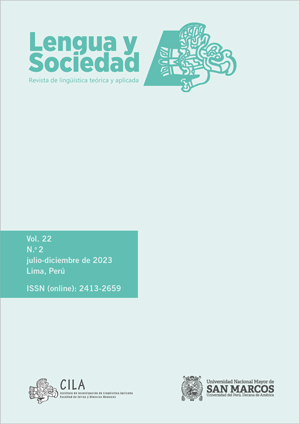The Beneficiary's case in Quechua and Spanish
DOI:
https://doi.org/10.15381/lengsoc.v22i2.25249Keywords:
Spanish morphology, Quechua morphology, spatial pragmatics, deixis, contrastive linguisticsAbstract
This article discusses the role of the pragmatic internal suffix -pu- of Quechua, correlated with -mu-, and its complex relationship with the casual peripheral suffix -paq, in order to warn about its syntactic-pragmatic dysfunctionality despite covering semantically both the Recipient field. It will also be analyzed if there is a similar parallelism between the unstressed pronouns (me, te, se, lo...), the suffix -ario and the preposition para in the Spanish language. The Quechua-Spanish contrast will make it possible to ensure that the pragmatic projection is similar in the two languages, although morphologically and syntactically they are so different.
References
Albarracín, L. I. (2011). La Quichua. Volumen II: Gramática, Ejercitaciones y Diccionario Quichua-Castellano. Dunken.
Albarracín, L. I. y Alderetes, J. R. (2014). El sufijo -pu- del quichua de Santiago del Estero. En M. Malvestitti y P. Dreidemie (Compils.), Actas del III Encuentro de Lenguas Indígenas Americanas (ELIA) (pp. 23-33). Universidad Nacional de Río Negro.
Albarracín, L. I. y Gómez Nazar, R. F. (2021). Variación actancial en quichua santiagueño: los aplicativos (Parte I). Lengua y Sociedad, 20(1), 13-32. https://doi.org/10.15381/lengsoc.v20i1.22266
Albarracín, L. I. y Gómez Nazar, R. F. (2022). Variación actancial en quichua santiagueño: los aplicativos (Parte II). Lengua y Sociedad, 21(1), 13-29. https://doi.org/10.15381/lengsoc.v21i1.22617
Calvo Pérez, J. (1985). Clasificación semántica de los adjetivos puros del español contemporáneo [Tesis de doctorado, Universitat de València].
Calvo Pérez, J. (1996-1997). Pronominalización en español andino: Ley de mínimos e influencia del quechua y del aimara. Anuario de Lingüística Hispánica (In honorem Germán de Granda), 12/13, 521-543.
Calvo Pérez, J. (1993). Pragmática y gramática del quechua cuzqueño. CERA Bartolomé de las Casas.
Calvo Pérez, J. (1994). Introducción a la pragmática del español. Cátedra.
Calvo Pérez, J. (2005). Transitividad, aglutinación y subordinación en lengua quechua. Lexis, 29(1), 79-96. https://doi.org/10.18800/lexis.200501.004
Calvo Pérez, J. (2009). Deixis verbal en quechua: -mu- y -pu- a la luz de la lexicología. Revista Española de Lingüística, 39(2), 63-92.
Calvo Pérez, J. (2011). La fundación de la semántica: los espines léxicos como un universal del lenguaje. Iberoamericana Vervuert.
Cusihuamán, A. (1976). Gramática quechua Cuzco-Collao. Ministerio de Educación e Instituto de Estudios Peruanos.
Daneš, F., Horálek, K., Skalicka, V., Trost, P. y Vachek, J. (Eds.). (1966). Les problèmes du centre et de la périphérie du système de la langue. Travaux linguistiques de Prague 2. Editions de l’Académie Tchécoslovaque des Sciences.
Dervillez-Bastuji, J. (1982). Structures des relations spatiales dans quelques langues naturelles. Introduction á une théorie sémantique. Librairie Droz.
Fernández Ramírez, S. (1975). Derivados españoles en -ivo. Archivum, 25, 323-327.
Fillmore, C. J. (1968). The case for case. En E. Bach y R. Harms (Eds.), Universals in Linguistic Theory (pp. 1-90). Holt, Rinehart, and Winston.
Gonçález Holguín, D. (1607). Gramática y arte nueva de la general de todo el Perú, llamada lengua Qquichua, o lengua del Inca. Ciudad de los Reyes (Lima): Francisco del Canto.
Hudson, R. (1984). Word Grammar. Basil Blackwell.
Langacker, R. (1987). Foundations of cognitive grammar: Theoretical prerequisites. Stanford University Press.
Lakoff, G. y Johnson, M. (1980). Metaphors we live by. The University of Chicago Press.
Llorente, A. y Mondéjar, J. (1974). La conjugación objetiva en español. Revista Española de Lingüística, 4(1), 1-60.
Myler, N. (2018). Variation in the syntax and semantics of predicative possession in Quechua. En M. Keough, N. Weber, A. Anghelescu, S. Chen, E. Guntly, K. Johnson, D. Reisinger y O. Tkachman (Eds.), Proceedings of the Workshop on the Structure and Constituency of the Languages of the Americas (Vol. 21, pp. 154-168). University of British Columbia.
Rosch, E. H. (1973). Natural categories. Cognitive Psychology, 4(3), 328-350. https://doi.org/10.1016/0010-0285(73)90017-0
Sadock, J. M. (1991). Autolexical syntax. Studies in Contemporary Linguistics. The University Chicago Press.
De Santo Thomás, D. (1560). Grammatica o arte de la lengua general de los indios de los reynos del Peru. Seguida del Lexicon o Vocabulario de la lengua general del Peru. Valladolid, Francisco Fernández de Córdova.
Talmy, L. (1983). How language structure space. En H. Pick y L. Acredolo (Eds.), Spatial theory, orientation: research, and application (pp. 225-282). Plenum Press.
Talmy, L. (2005). The fundamental system of spatial schemas in language. En B. Hamp (Ed.), Perception to Meaning: Image Schemas in Cognitive Linguistics (pp. 199-234). Mouton de Gruyter.
Taylor, J. R. (1995). Linguistic Categorization. Prototypes in Linguistic Theory. Oxford University Press.
Torero, A. (2002). Idiomas de los Andes. Lingüística e Historia. IFEA, Horizonte.
Winther, A. (1975). Notes sur les formations déverbales en -eur et en -ant. Cahiers de Lexicologie, 23, 56-84.
Downloads
Published
Issue
Section
License
Copyright (c) 2023 Julio Calvo

This work is licensed under a Creative Commons Attribution 4.0 International License.
AUTHORS RETAIN THEIR RIGHTS
a. Authors retain their trade mark rights and patent, and also on any process or procedure described in the article.
b. Authors can submit to the journal Lengua y Sociedad, papers disseminated as pre-print in repositories. This should be made known in the cover letter.
c. Authors retain their right to share, copy, distribute, perform and publicly communicate their article (eg, to place their article in an institutional repository or publish it in a book), with an acknowledgment of its initial publication in the journal Lengua y Sociedad.
d. Authors retain theirs right to make a subsequent publication of their work, to use the article or any part thereof (eg a compilation of his papers, lecture notes, thesis, or a book), always indicating its initial publication in the journal Lengua y Sociedad (the originator of the work, journal, volume, number and date).






